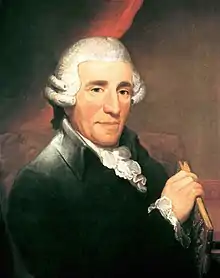Symphony No. 41 (Haydn)
The Symphony No. 41 in C major, Hoboken I/41, is a festive symphony[1] by Joseph Haydn. The symphony was composed by 1769. It is scored for flute, two oboes, bassoon, two horns, two trumpets, timpani and strings.[2]

Joseph Haydn
The work is in four movements:
The flute appears only in the slow movement where it is featured prominently in several elegant solo passages. This is not unusual for Haydn's symphonies. Using that type of solo usually would seem out of place in the classical symphony. He felt the complete freedom to innovate as he wished, as he was composing in the relatively isolated palace of Esterhaza.
References
- Antony Hodgson, The Music of Joseph Haydn: The Symphonies. London: The Tantivy Press (1976): 71. "Symphony No. 41 in C is one of the important Festive Symphonies, a composition of no little magnificence."
- H. C. Robbins Landon, The Symphonies of Joseph Haydn. London: Universal Edition & Rockliff (1955): 677. "1 fl. (in II only), 2 ob., 2 cor. in C alto & C basso, 2 clarini (trpt.), timp., str. (fag.)."
This article is issued from Wikipedia. The text is licensed under Creative Commons - Attribution - Sharealike. Additional terms may apply for the media files.